Volume. 1, July - September, 2012 - amam-ayurveda.org
Volume. 1, July - September, 2012 - amam-ayurveda.org
Volume. 1, July - September, 2012 - amam-ayurveda.org
Create successful ePaper yourself
Turn your PDF publications into a flip-book with our unique Google optimized e-Paper software.
of Solvent Ether. Pack the whole mass in a percolator, allow to macerate<br />
for thirty minutes and extract with Solvent Ether till the ethereal solution<br />
ceases to give a pink colour with a drop of Dilute Ammonia Solution. Distil<br />
off the Ether, treat the residue with small quantity of light Petroleum (b.p.<br />
40° C to 60° C) cool in ice, filter through a Buchner funnel under suction<br />
and reject the filtrate. Wash the residue with further small quantities of<br />
cooled Ether (b. p. 40° C to 60° C). Transfer the residue to a tared beaker<br />
with sufficient quantity of Solvent Ether, remove the Light Petroleum and<br />
dry the residue of embelin to constant weight at 80°. The melting range of<br />
the residue is 142° C to 144° C.<br />
CONSTITUENTS - Benzoquinones, alkaloid (Christembine), tannin and<br />
essential oil<br />
PROPERTIES AND ACTION<br />
Rasa: Katu, Tikta<br />
Guna: Ruksha, Laghu, Tikshna<br />
Virya: Ushna<br />
Vipaka: Katu<br />
Karma: Kriminashna, Dipana, Anulomana, Vatakaphapaha<br />
IMPORTANT FORMULATIONS- Vidangarishta, Vidanga Lauha,<br />
Vidangadi Lauha<br />
THERAPEUTIC USES- Krimiroga, Adhmana, Shula, Udararoga<br />
DOSE- 5-10 g of the drug in powder form.<br />
DANTI (Root)<br />
(API Part - I, <strong>Volume</strong> -III, Page 41)<br />
Danti consists of dried root of Baliospermum montanum Muell.-Arg.<br />
(Fam.Euphorbiaceae); a leafy undershrub, distributed in outer range<br />
of Himalayas from Kashmir to Assam and in moist deciduous forests<br />
elsewhere in India.<br />
SYNONYMS<br />
Sanskrit : Danti<br />
Assamese : Danti<br />
Bengali : Danti<br />
English: Wild Croton<br />
Gujrati: Danti<br />
Hindi: Danti<br />
Kannada : Kadu Haralu<br />
Malayalam : Neervalam, Dantti<br />
Marathi : Danti<br />
Oriya : Danti<br />
Punjabi : Danti<br />
Tamil : Danti<br />
Telugu : Konda Amudamu<br />
Urdu: Danti<br />
Info Ayurveda, <strong>Volume</strong> 2, No.1, <strong>July</strong> to <strong>September</strong>’ <strong>2012</strong><br />
DESCRIPTION<br />
a) Macroscopic<br />
Root pieces almost cylindrical, straight or ribbed with secondary and<br />
tertiary roots, 0.2-1 cm thick and upto 10 cm or more in length, tapering<br />
at one end, tough, externally brown; surface, rough due to longitudinal<br />
striations, transverse cracks and scars of rootlets; internally creamcoloured;<br />
transversely smoothened root shows thin, brown bark and<br />
yellowish-white central core; taste, bitter.<br />
b) Microscopic<br />
Shows 5-18 layered cork, consisting of brown coloured, suberised or<br />
lignified brickshaped cells, a few cells containing tannin and red colouring<br />
matter; secondary cortex consists of 2-7 layers of oval to elliptical,<br />
tangentially elongated cells, a few cortical fibres are also present in this<br />
region; secondary phloem consists of usual elements, traversed by uni<br />
to biseriate phloem rays; secondary xylem consists of usual elements;<br />
vessels and tracheids, bordered pits, a few having reticulate thickening;<br />
fibres slightly thick-walled, narrow lumen and blunt tips; xylem rays 1 or<br />
2 cells wide; rosette crystals of calcium oxalate and starch grains, present<br />
only in secondary cortex and phloem; starch grains solitary and in groups,<br />
simple, round to oval measuring 6-17 μ in dia.<br />
Powder - Brown; shows fragments of cork more or less rectangular, thickwalled<br />
in surface view; rosette crystals of calcium oxalate; numerous<br />
phloem fibres with narrow lumen and blunt tips, border pitted- and<br />
reticulate vessels, tracheid and tannin cells, round to oval simple starch<br />
grains measuring 6-17 μ in diameter, and in groups occasionally.<br />
IDENTITY, PURITY AND STRENGTH<br />
Foreign matter - Not more than 2 per cent,<br />
Total Ash - Not more than 10 per cent,<br />
Acid-insoluble ash - Not more than 3 per cent,<br />
Alcohol-soluble extractive - Not less than 1.5 per cent,<br />
Water-soluble extractive - Not less than 3 per cent,<br />
T.L.C.<br />
T.L.C. of the alcoholic extract on Silica gel ‘G’ plate using Toluene:<br />
Ethylacetate (9:1) shows under U.V. (366 nm) a fluorescent zone at Rf<br />
0.65 (blue). On exposure to Iodine vapour two spots appear at Rf 0.51<br />
and 0.65 (both yellow). On spraying with 50% Methanolic-Sulphuric acid<br />
reagent and heating the plate for ten minutes at 110°C two spots appear at<br />
Rf 0.51 and 0.65 (both grey).<br />
CONSTITUENTS - β - Sitosterol and Triterpenoids, Resinous<br />
Glycosides, Phorbol Esters.<br />
PROPERTIES AND ACTION<br />
Rasa: Katu<br />
Guna: Tikshna, Sara, Laghu<br />
Virya: Ushna<br />
Vipaka: Katu<br />
Karma: Kaphahara, Raktadoshahara, Vidahara, Dipana, Rocaka,<br />
Shodhaka, Vikasi, Vrana<br />
IMPORTANT FORMULATIONS<br />
Dantyadyarishta, Punarnava Mandura, Abhayarishta, Kankayana Gutika,<br />
Dantiharitaki, Kalyanaka Kshara, Kaishora Guggulu<br />
THERAPEUTIC USES<br />
Tvak dosha, Daha, Shotha, Udararoga, Sularoga, Krimi, Arsha, Ashmari,<br />
Kandu, Kushtha, Vrana, Pliha Vriddhi, Gulma, Kamala<br />
DOSE - 1-3 g of the drug in powder form<br />
10


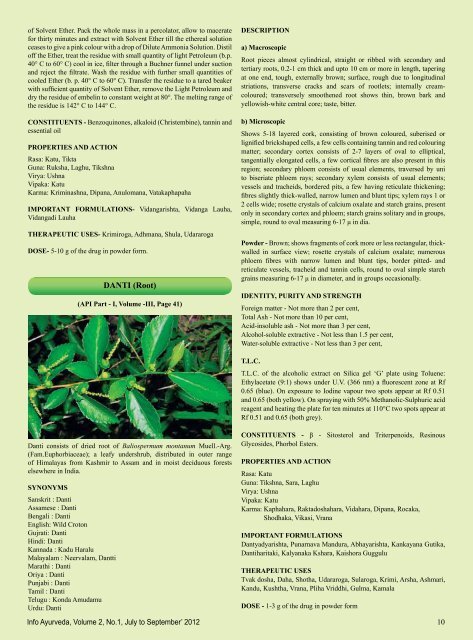

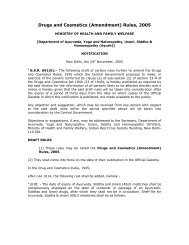
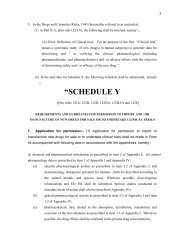
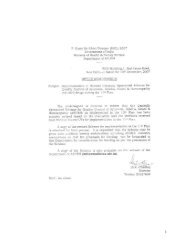

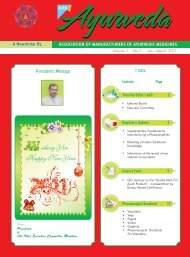

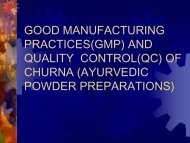
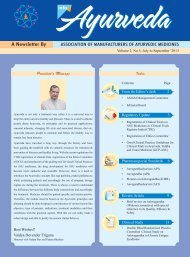
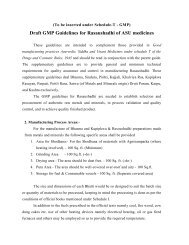
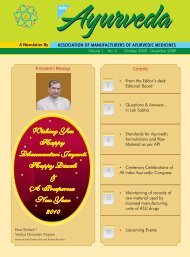
![[To be published in Gazette of India Part II Section 3, sub-section iii]](https://img.yumpu.com/28570283/1/190x245/to-be-published-in-gazette-of-india-part-ii-section-3-sub-section-iii.jpg?quality=85)

